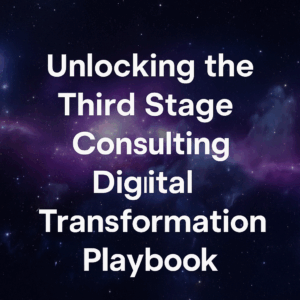In the realm of digital transformation, organizations frequently prioritize the technological facets of implementation, sometimes neglecting essential non-technical elements crucial to project success. Achieving a successful digital strategy implementation requires organizations to expand their viewpoint beyond systems and tools. They must address fundamental human and organizational factors that underpin successful change. This broader perspective encompasses considerations such as cultural alignment, change management, stakeholder engagement, and skills development. By focusing on these aspects alongside technology, organizations can enhance adoption rates, minimize resistance, and maximize the return on investment from digital initiatives.
Organizations must recognize that successful digital transformation involves more than just deploying new systems or technologies. It requires fostering a culture of innovation, continuous learning, and adaptability. Building organizational readiness for change, nurturing leadership alignment, and empowering employees to embrace new ways of working are pivotal to navigating the complexities of digital strategy implementation. Ultimately, by integrating both technical and human-centric approaches, organizations can navigate digital transformations more effectively, driving sustainable growth and competitive advantage in today’s rapidly evolving business landscape.
Table of Contents
ToggleThe Change Impact List: Beyond Technology
A comprehensive Change Impact List is indispensable for anticipating and addressing challenges during digital strategy implementation. This list extends beyond technical considerations to encompass crucial elements such as time scaling, toolset alignment, and job role transitions. By identifying potential gaps in training, role clarity, and tools needed to support the new strategy, organizations can proactively mitigate risks and ensure a smoother transition. This proactive approach helps align organizational resources with strategic objectives, fostering a more cohesive and efficient implementation process.
Successful change management requires attention to critical behaviors, attitudes, and mindsets within the organization. Establishing a culture that embraces change, fosters open communication, and encourages continuous learning is foundational to overcoming resistance and driving sustained adoption of new technologies. Leaders play a pivotal role in modeling desired behaviors and reinforcing the importance of adapting to evolving business requirements. By prioritizing cultural alignment alongside technical deployment, organizations can cultivate an environment conducive to innovation and growth.
Reporting structures, performance evaluation criteria, and compensation models may need to be realigned to support the new digital strategy implementation. Addressing these aspects proactively ensures clarity and transparency in roles and responsibilities, reducing ambiguity and enhancing accountability. Additionally, considering location consolidation, process refinement, and goal setting as part of the change impact assessment enables organizations to anticipate broader implications and adjust implementation plans accordingly. This holistic approach to change management empowers organizations to navigate digital transformations effectively, driving sustainable success and maximizing the value derived from digital initiatives.
Organizational Structures and Cultural Alignment
Implementing a digital strategy often necessitates structural and cultural adjustments within an organization. Changes in job roles, reporting relationships, and performance expectations can impact employee morale and productivity. Clear communication about revised processes, performance evaluation criteria, and compensation structures is essential to maintaining trust and engagement during periods of transition.
Furthermore, consolidating diverse business units or locations into a unified entity requires deliberate efforts to bridge cultural gaps and foster a cohesive organizational identity. Building a shared vision and cultivating a collaborative culture are key to ensuring alignment with the digital strategy’s objectives.
Holistic Change Management for Success
Achieving success in digital strategy implementation demands holistic change management that considers both technological and human dimensions. Understanding the interconnectedness of processes, people, and culture is critical for realizing desired outcomes. By prioritizing stakeholder engagement, addressing concerns proactively, and leveraging data-driven insights, organizations can navigate digital transformations with confidence and drive sustainable growth.
In conclusion, effective digital strategy implementation transcends technology alone, requiring a comprehensive approach that integrates organizational dynamics, cultural nuances, and change readiness. By embracing holistic change management principles and fostering a supportive environment for innovation, organizations can maximize the value of their digital investments and position themselves for long-term success in today’s dynamic business landscape.

How Can We Help
At Third Stage Consulting, we’re committed to helping organizations navigate the complexities of digital transformation, including Navigating the Pitfalls of Digital Strategy Implementation. Whether you’re embarking on a new transformation journey or seeking to optimize existing processes, our team is here to support you every step of the way.





